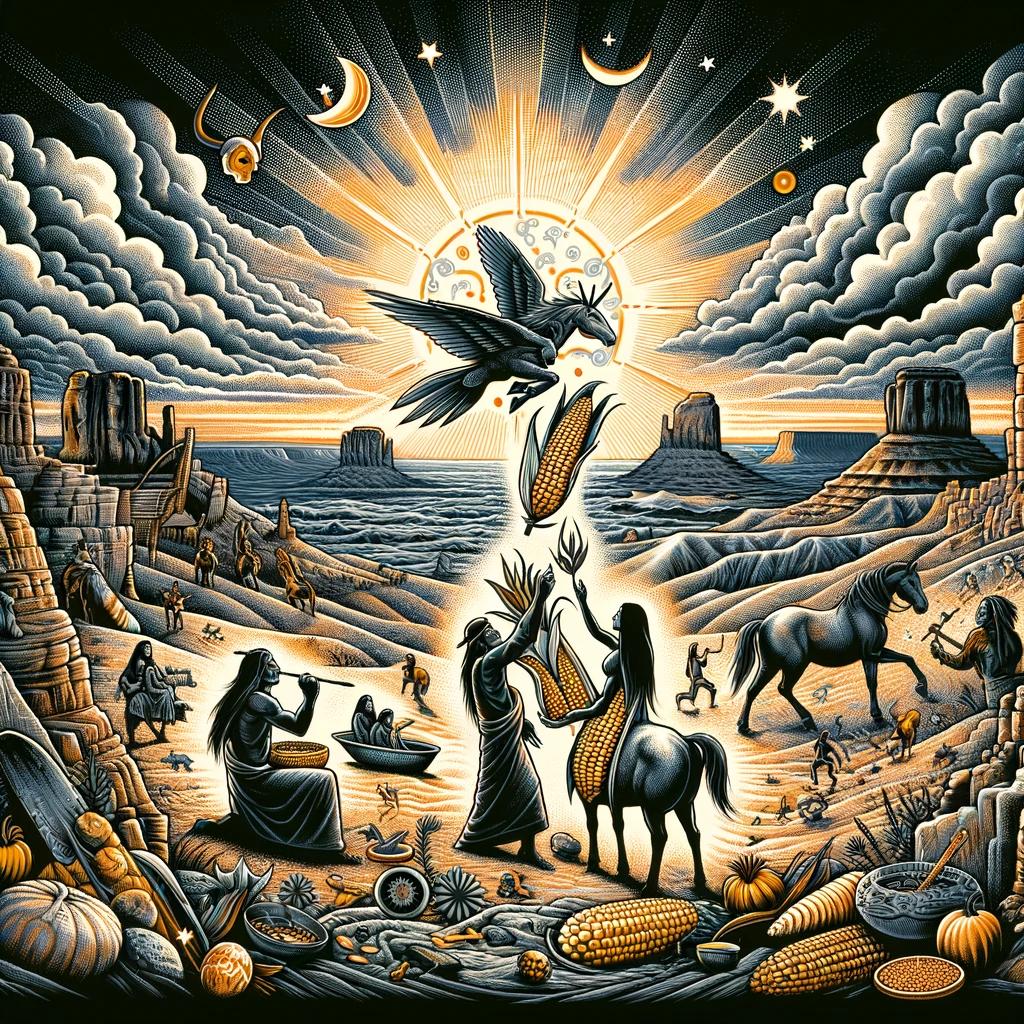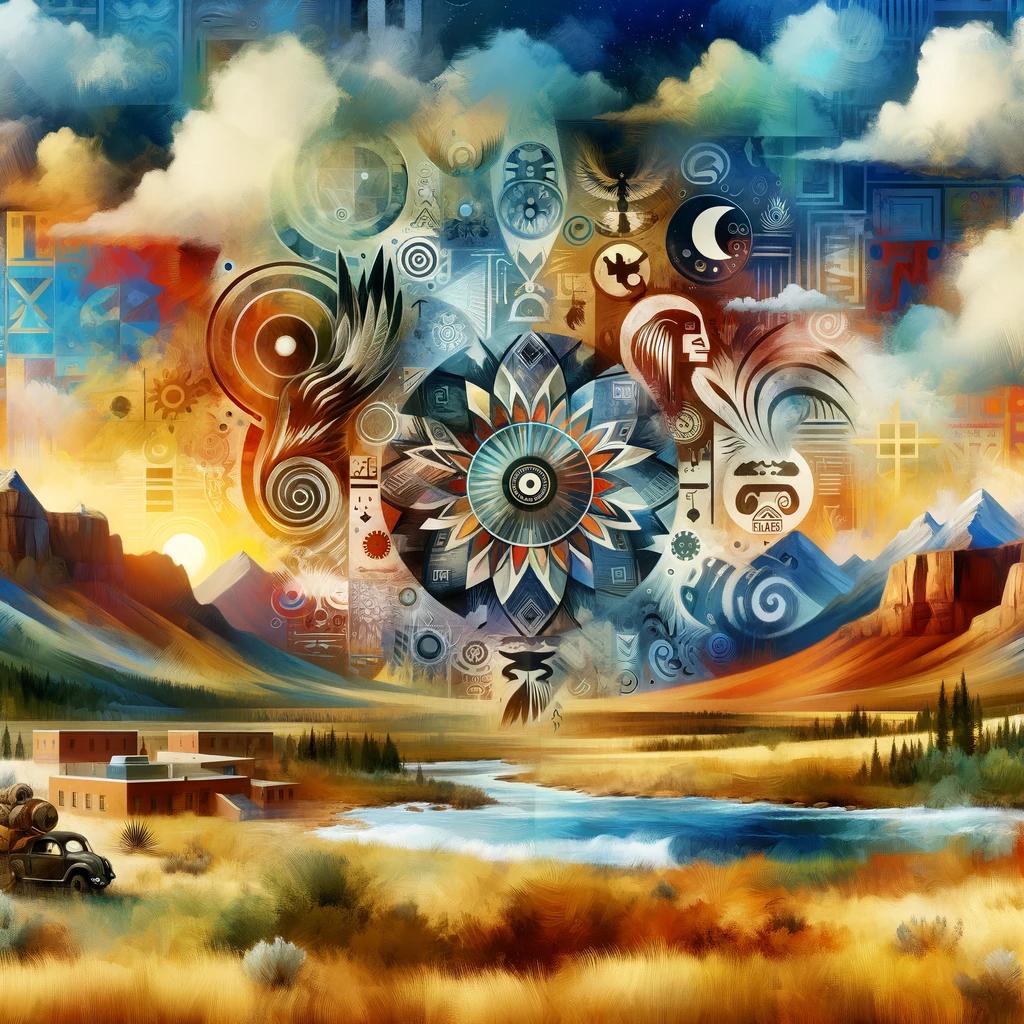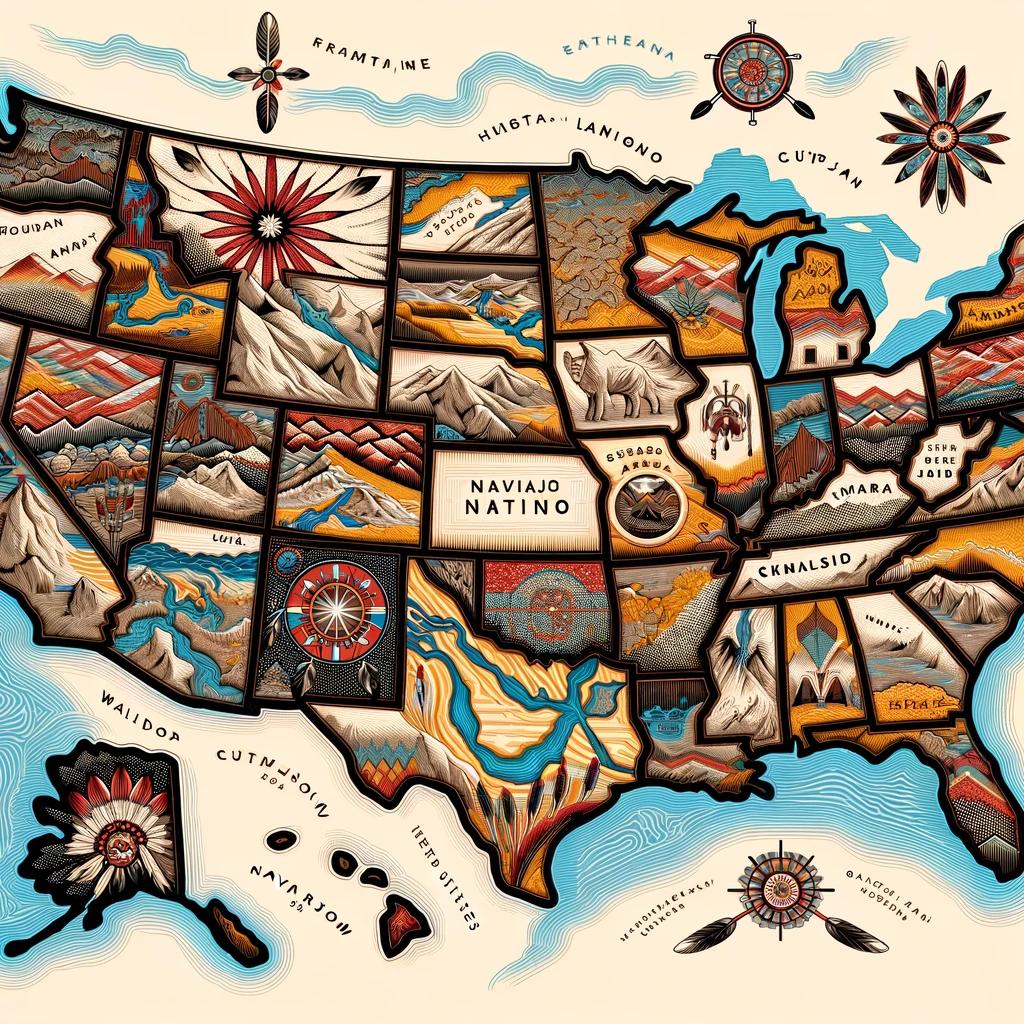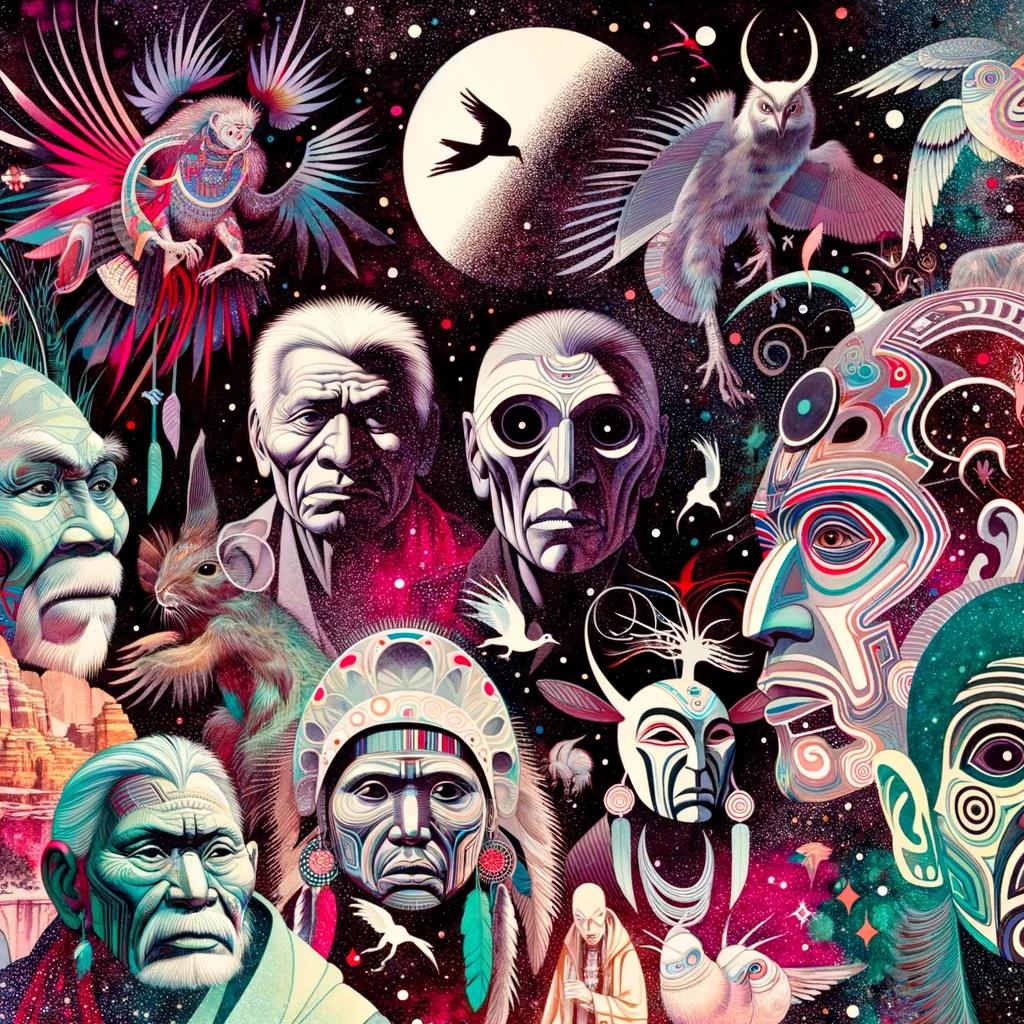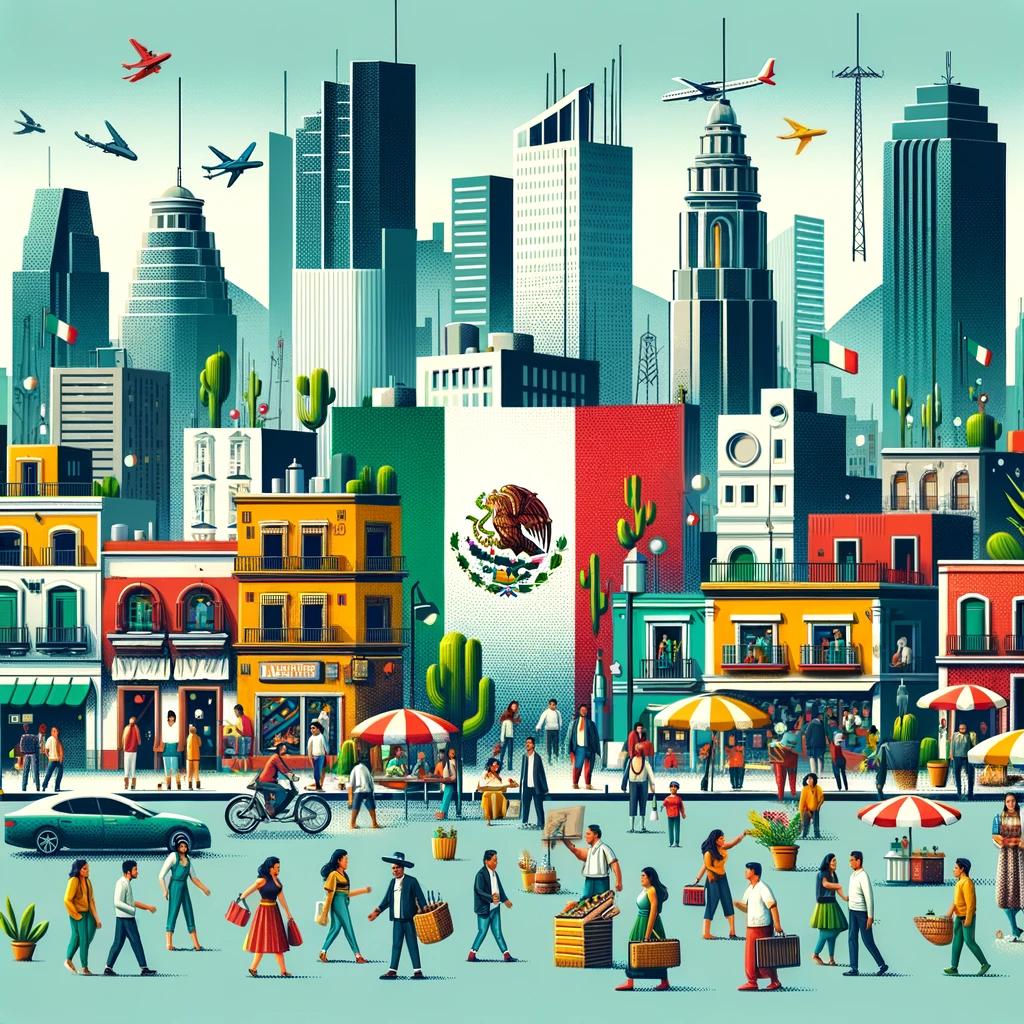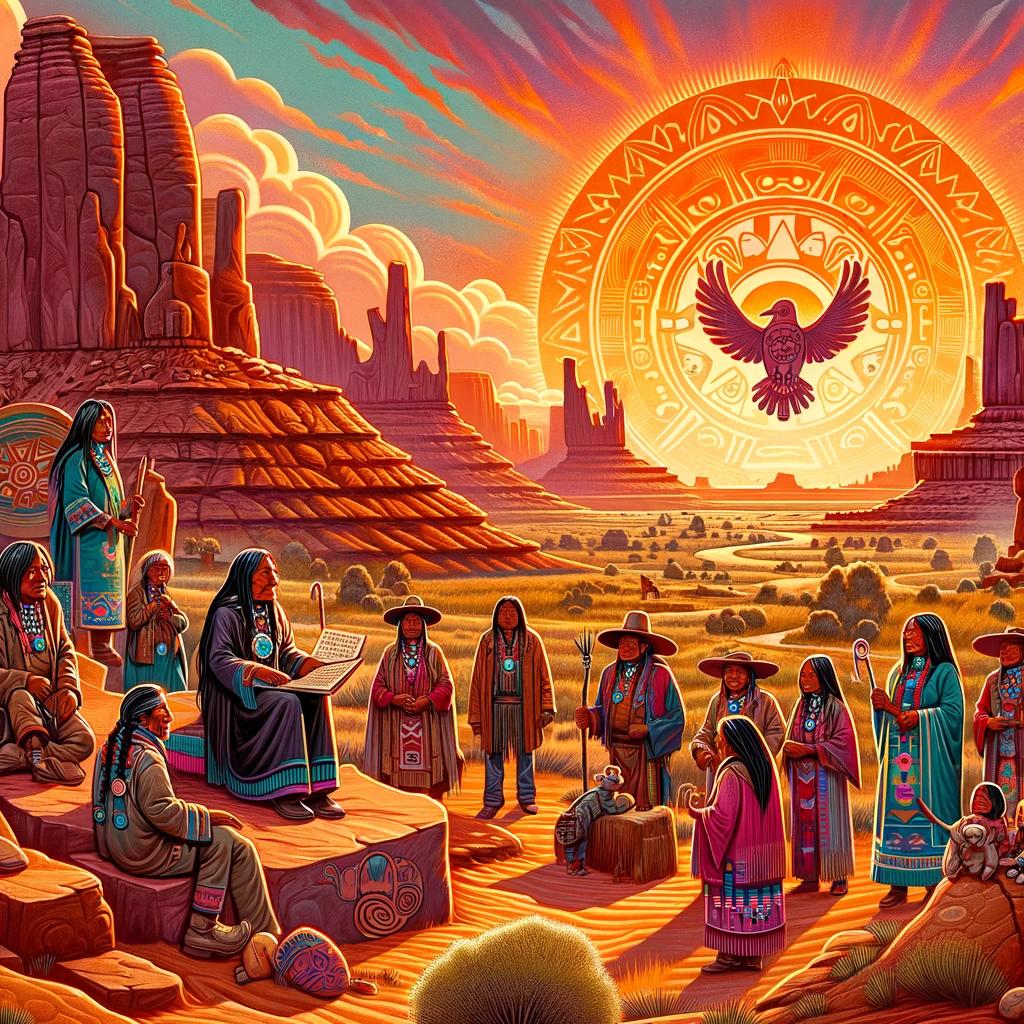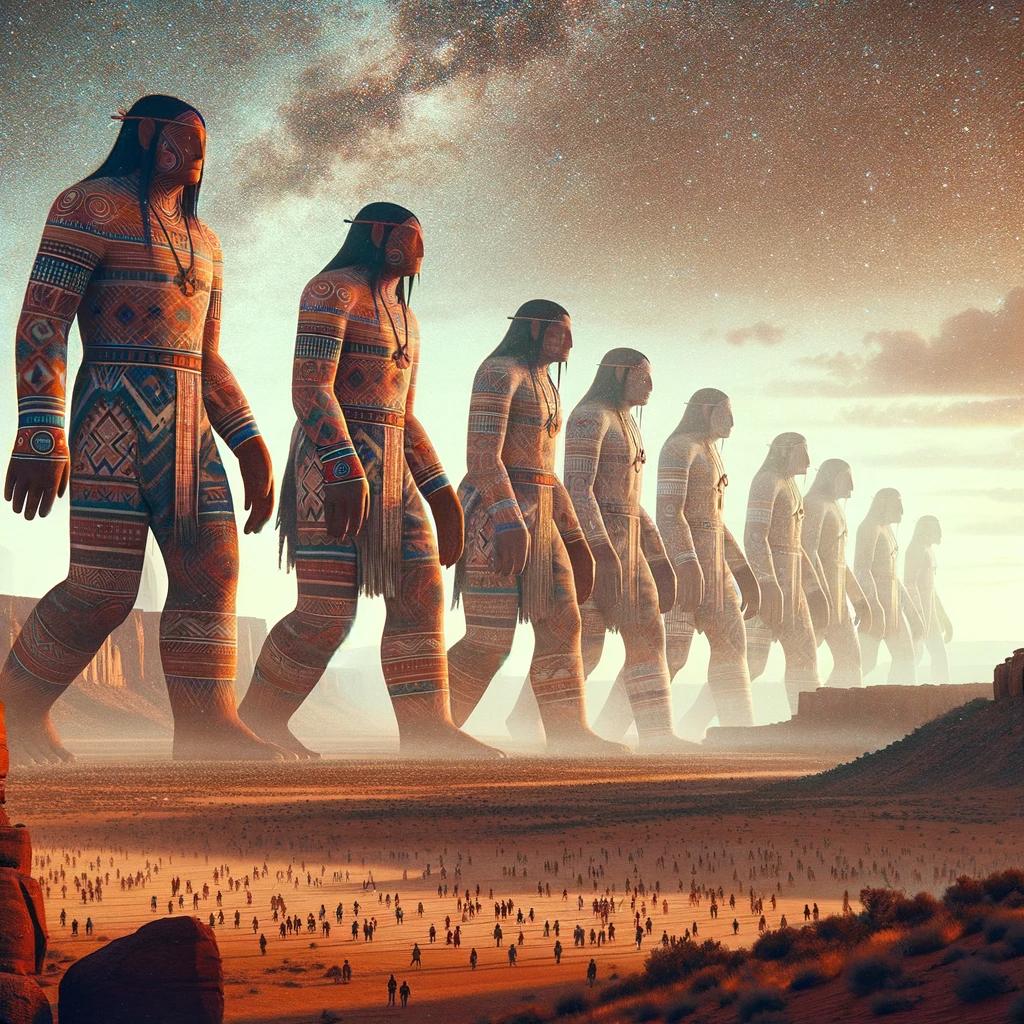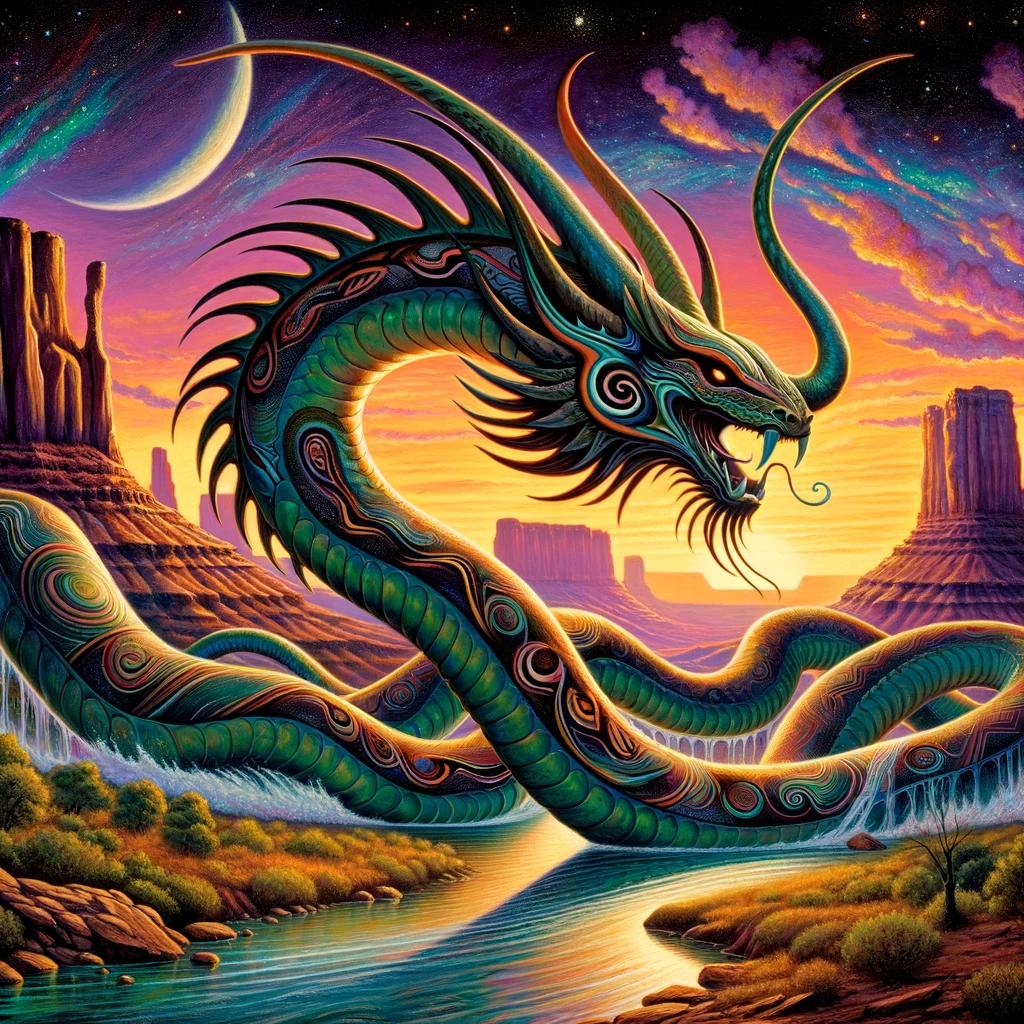Navajo Origin Story: Exploring the Mythical Beginnings of the Navajo Nation
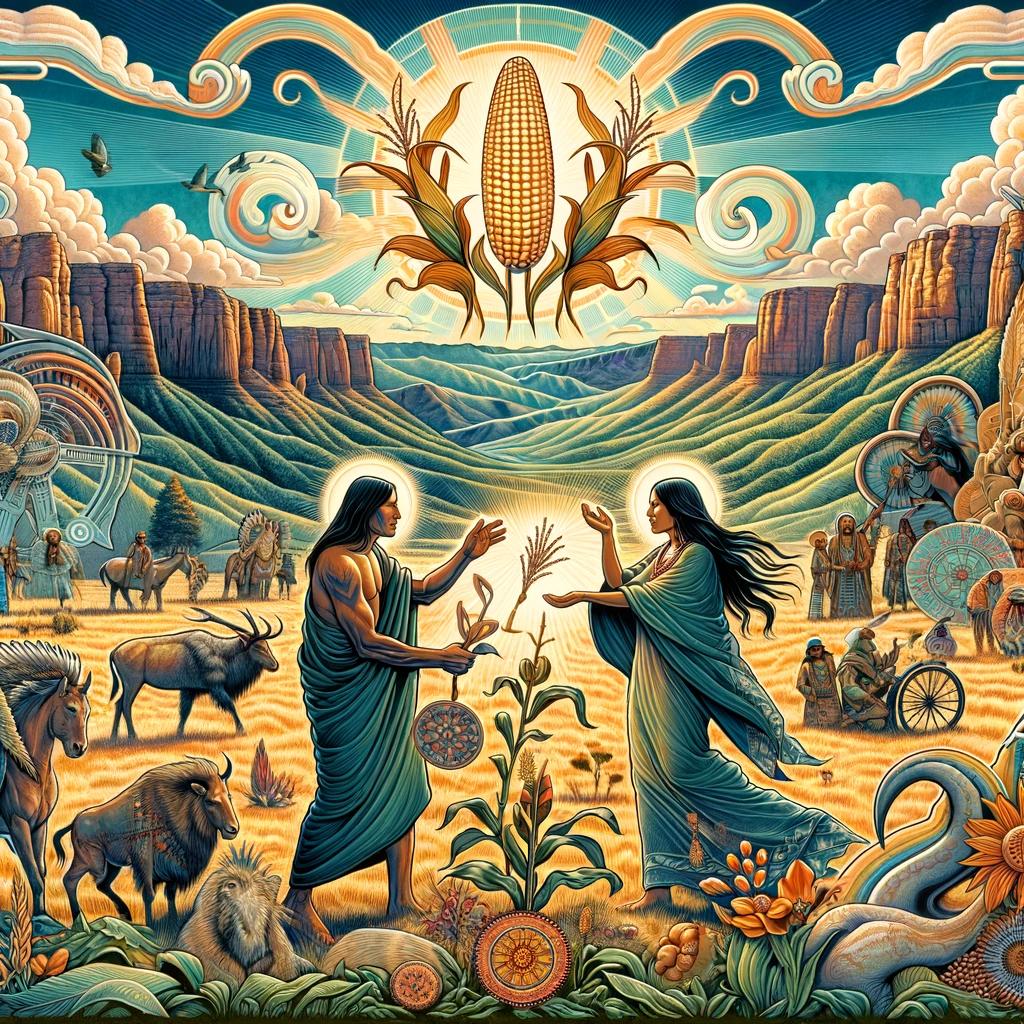
The Navajo Origin Story is a captivating tale passed down through generations. It recounts the mythical beginnings of the Navajo Nation, tracing the creation of the Four Worlds and the emergence of the Navajo people.
This rich narrative forms the foundation of Navajo culture, influencing their beliefs, ceremonies, and connection to sacred places. In this article, we delve into the significance of the Navajo Origin Story and explore its enduring impact on Navajo identity, traditions, and contemporary challenges.
Join us on this fascinating journey into the heart of Navajo mythology and culture.
The Navajo Reservation
The Navajo Reservation, also known as the Navajo Nation, is the largest Native American reservation in the United States. Spanning over 27,000 square miles across the states of Arizona, New Mexico, and Utah, the Navajo Reservation is home to the Navajo people, one of the largest federally recognized tribes in the country.
Historical Overview of the Navajo Reservation
The establishment of the Navajo Reservation can be traced back to the Treaty of 1868, signed between the Navajo people and the United States Government. This treaty confirmed the Navajo’s right to their ancestral lands and provided a legal framework for the reservation’s creation.
Over the years, the Navajo Reservation has witnessed significant historical events, including the Long Walk of 1864 when thousands of Navajo were forcibly removed from their lands and interned at Fort Sumner in New Mexico.
Impact of the Navajo Reservation on Navajo Culture and Language
The Navajo Reservation has played a crucial role in preserving and perpetuating Navajo culture and language. Within the reservation, Navajo traditions, ceremonies, and oral histories have been passed down through generations, contributing to the preservation of their rich cultural heritage.
The isolation of the reservation has also helped in maintaining the Navajo language, which is widely spoken by tribal members.
Socioeconomic Challenges and Opportunities on the Navajo Reservation
While the Navajo Reservation is a land of cultural significance, it also faces various socioeconomic challenges. High unemployment rates, limited access to education, healthcare disparities, and inadequate infrastructure are some of the pressing issues that impact the Navajo people.
However, the reservation possesses opportunities for economic growth and development, including natural resources such as coal, uranium, and oil, as well as tourism potential with its stunning landscapes and cultural attractions.
The Navajo Reservation stands as a testament to the resilience and strength of the Navajo people, who continue to navigate through historical, cultural, and socioeconomic dynamics while preserving their unique heritage.
The Navajo Language
The Navajo language is a complex and fascinating linguistic system that holds a central position in Navajo culture and identity. It has a long and rich history, with origins tracing back to the Athabaskan language family, believed to have migrated from northern Canada to the Southwest United States thousands of years ago.
Origins and Evolution of the Navajo Language
The Navajo language, also known as Diné Bizaad, developed and evolved over centuries within the Navajo community. It has been shaped by cultural interactions, historical events, and connections with neighboring tribes and European settlers.
Navajo experienced significant changes during the forced relocation known as the Navajo Long Walk in the mid-1800s, as well as through interactions with the United States government and missionary efforts. Despite these challenges, the Navajo language persevered and adapted, retaining its distinct characteristics and structure.
Unique Characteristics and Structure of the Navajo Language
Navajo is a highly complex language, known for its intricate grammatical and syntactical structure. It is classified as a tonal language, meaning that pitch variations can change the meaning of words.
Additionally, it is agglutinative, with extensive use of prefixes, suffixes, and affixes to convey grammatical information.
One of the unique features of Navajo is its extensive verb system, which includes aspects such as directionality, completion, duration, and repetition.
Nouns, pronouns, and verbs in Navajo also exhibit complex systems of classification, with different word forms used depending on factors like animacy, shape, and size.
Efforts to Preserve and Revitalize the Navajo Language
In recent years, there has been a significant focus on preserving and revitalizing the Navajo language.
Recognizing its importance as a cultural treasure and a vital tool for intergenerational communication, various initiatives have been undertaken to promote its usage.
Navajo Nation schools and educational programs incorporate Navajo language instruction, aiming to provide students with fluency in both Navajo and English.
Language immersion schools have also been established, where instruction is solely conducted in Navajo. Additionally, community-based language programs, language camps, and online resources contribute to language revitalization efforts.
Despite these efforts, the Navajo language faces challenges such as the predominance of English in everyday life and the increasing influence of modern technology.
However, the resilience and determination of the Navajo community continue to drive ongoing efforts to ensure the endurance and vibrancy of the Navajo language for future generations.
The Navajo Tribe
The Navajo Tribe, also known as the Diné, has a rich history that dates back centuries. This section delves into the fascinating historical journey and migration of the Navajo Tribe, shedding light on their origins and their interactions with other indigenous communities.
History and Migration of the Navajo Tribe
The history of the Navajo Tribe is intricately linked to their migration from Canada and subsequent settlement in the southwestern United States. Explore how the Navajo people faced challenges and adapted to new environments as they traversed vast territories during their migratory journey.
Traditional Navajo Beliefs and Practices
The Navajo Tribe has a deep spiritual connection to the land, nature, and their ancestors. Discover the traditional Navajo beliefs, encompassing the concept of harmony and balance in their relationship with the world around them.
Learn about Navajo ceremonies, sacred rituals, and the importance of oral traditions in preserving their cultural heritage.
Modern Navajo Tribal Governance and Institutions
In this section, we will discuss the modern governance structures and institutions of the Navajo Tribe. Explore the Navajo Nation’s political organization and leadership, as well as the development of tribal government systems to address the needs and aspirations of their community.
Gain insights into the current challenges and opportunities faced by the Navajo Tribe in maintaining their sovereignty and promoting the well-being of their people.
Navajo Culture and Traditions
Navajo culture is a vibrant and rich tapestry of traditions, beliefs, and artistic expressions. It encompasses various aspects, including the Navajo creation myth, ceremonies and rituals, as well as art, crafts, and cuisine.
Navajo Creation Myth: The Story of the Four Worlds
The Navajo creation myth, known as the Story of the Four Worlds, is central to the cultural fabric of the Navajo people. According to this myth, the Navajo emerged from four different worlds, each representing a different stage in their spiritual journey.
This myth explains the origins of the Navajo people and serves as a fundamental belief system that guides their worldview.
The Importance of Navajo Ceremonies and Rituals
Ceremonies and rituals hold immense significance in Navajo culture. They are conducted to restore balance, harmony, and spiritual well-being within the individual and the community. Navajo ceremonies encompass a wide range of practices, such as the Blessingway ceremony, Kinaalda (coming-of-age ceremony), and the Enemy Way ceremony.
These rituals preserve cultural heritage and maintain the sacred connection between the Navajo people, their ancestors, and the natural world.
Art, Crafts, and Cuisine in Navajo Culture
Art and crafts play a vital role in Navajo culture, serving as a means of both artistic expression and cultural preservation. Navajo artisans are renowned for their intricate weaving, exquisite silverwork, and vibrant pottery.
These artistic forms not only showcase the Navajo aesthetic but also provide economic opportunities for the community.
Navajo cuisine is a reflection of their close connection with the land and nature.
Traditional dishes often include ingredients like corn, beans, squash, and meat from animals such as sheep and deer. Frybread, a beloved staple, is a testament to the resilience and adaptability of the Navajo people.
Overall, Navajo culture and traditions are deeply rooted in their rich history, sacred beliefs, and artistic expressions. They continue to thrive and evolve, nurturing a strong sense of identity and resilience among the Navajo people.
Navajo Legends and Heroes
The Legend of the Heroic Twins: Monster Slayer and Born-for-Water
The Navajo nation is steeped in captivating legends and heroic tales that have been passed down through generations. Among these stories, the legend of the Heroic Twins, Monster Slayer and Born-for-Water, stands out as a remarkable tale of bravery and triumph.
As the sons of Changing Woman, these twins were destined to confront the monstrous creatures threatening the Navajo people.
In their epic quest, Monster Slayer and Born-for-Water faced formidable challenges, battling fearsome monsters and navigating treacherous landscapes.
With their supernatural powers and unwavering determination, they triumphantly defeated these malevolent beings, providing protection and peace to the Navajo people.
- Monster Slayer, armed with his lightning bolts and sacred weapons, demonstrated his formidable strength and unyielding spirit.
- Born-for-Water utilized his powers over rain and water to harness their life-giving energy and heal the wounds inflicted by the monsters.
The Divine Role of Changing Woman in Navajo Mythology
Changing Woman, known as Asdzą́ą́ Nádleehé, holds a divine and influential role in Navajo mythology.
She is revered as a primordial being who possesses the power to create and sustain life. Changing Woman is central to the Navajo Origin Story, as she embodies the essence of womanhood, fertility, and nurturing.
In the Origin Story, Changing Woman imprints her wisdom and teachings upon her twin sons, Monster Slayer and Born-for-Water. She guides them on their heroic journey, imparting knowledge, and bestowing them with sacred objects and rituals necessary to protect their people.
Tales of Coyote: Trickster and Teacher in Navajo Folklore
Navajo folklore is replete with tales of the mischievous yet wise Coyote. Known as Mą’ii, this enigmatic figure plays a dual role as a trickster and a teacher, imparting valuable lessons to the Navajo people.
Despite his unorthodox methods, Coyote’s antics carry profound messages and wisdom.
- Coyote trickster tales entertain and provide moral guidance, highlighting the consequences of greed, selfishness, and arrogance.
- Simultaneously, Coyote serves as an educator, teaching important skills, cultural customs, and survival techniques.
These enchanting stories featuring Coyote not only entertain but also serve as a means of preserving Navajo traditions and values, ensuring their transmission to future generations.
As we delve into the world of Navajo legends and heroes, we gain a deeper understanding of the bravery, wisdom, and resilience embedded within Navajo culture. The tales of Monster Slayer, Born-for-Water, Changing Woman, and Coyote continue to inspire and shape the collective identity of the Navajo people, reminding us of the power of stories to connect us to our heritage and preserve our cultural legacy.
Sacred Places in Navajo Culture
The Navajo people hold a deep reverence for their sacred places, which play a vital role in their spiritual and cultural traditions. These sites are imbued with profound significance, connecting the Navajo to their ancestral past, their land, and the forces of the natural world.
Let us delve into the richness of Navajo sacred places and explore their symbolic importance within their culture.
The Significance of the Four Sacred Mountains in Navajo Beliefs
Central to Navajo cosmology are the Four Sacred Mountains: Sisnaajiní (Blanca Peak) to the east, Dook’o’oosłííd (San Francisco Peaks) to the west, Tsoodził (Mount Taylor) to the south, and Dibé Nitsaa (Hesperus Mountain) to the north.
These mountains represent the cardinal directions and serve as the guardians of the Navajo people. They are seen as spiritual gateways to the divine and are associated with specific colors, deities, and ceremonies.
Navajo individuals undertake pilgrimages to these mountains, seeking guidance, healing, and a deepening of their spiritual connection.
The Holy People and their Connection to Navajo Land
In Navajo belief, the Holy People are powerful deities who emerged from the underworld, bringing with them essential knowledge, teachings, and ceremonies. They reside in specific natural features, often referred to as sacred sites or shrines, scattered throughout Navajo land.
These holy places, which include canyons, mountains, springs, and buttes, are considered living entities with their own consciousness and spiritual energy. The Navajo engage in ceremonial practices and offerings at these sites to honor the Holy People, seek blessings, and maintain harmony and balance with the natural world.
The Mythical Beings of Navajo Sacred Sites
Beyond the Holy People, Navajo sacred sites are also associated with various mythical beings. These beings are integral to Navajo origin stories and cosmology. They come in the forms of heroic figures, shape-shifters, tricksters, and protectors.
One notable example is the Yé’ii, or Holy People, who manifest as anthropomorphic figures representing different natural elements or aspects of life. They often inhabit sacred mountains, mesas, or caves and are invoked in ceremonies and rituals.
These beings serve as intermediaries between the human and spiritual realms, offering guidance, protection, and a deeper understanding of Navajo cultural wisdom.
As we delve into the significance of sacred places in Navajo culture, it becomes evident that these sites are more than physical locations.
They are sources of spiritual power, repositories of ancestral wisdom, and embodiments of Navajo identity. By recognizing the sacredness of these places, the Navajo people preserve their cultural heritage and ensure the continuation of their unique traditions for generations to come.
Cultural Influences and Interactions
The Navajo Nation’s relationship with neighboring tribes has played a significant role in shaping their cultural interactions. Through both cooperation and conflicts, these interactions have influenced the development of Navajo traditions and customs.
The exchange of knowledge, ceremonies, and trade between Navajo and neighboring tribes has enriched their cultural tapestry.
The Navajo Nation’s Relationship with Neighboring Tribes
- Shared customs and traditions with tribes like the Hopi, Zuni, and Ute have fostered cultural connections and intermingling.
- Intertribal gatherings, such as powwows and festivals, provide opportunities for Navajo people to celebrate and showcase their unique heritage.
- Historical conflicts, such as the Navajo Wars with Spanish settlers and subsequent engagements with the U.S.
government, have impacted relationships with neighboring tribes.
Interactions with European Settlers and the United States Government
European settlers and the United States government have significantly influenced Navajo culture through a complex history of interactions and policies.
- The arrival of European settlers and the establishment of trade routes led to the introduction of new technologies, materials, and concepts that impacted Navajo society.
- The Long Walk of 1864, when the U.S.
government forced Navajos to relocate to Bosque Redondo, had a profound effect on Navajo culture, resulting in significant changes to their way of life.
- The Treaty of 1868 and subsequent negotiations shaped the relationship between the Navajo Nation and the United States government, impacting Navajo governance and land rights.
Influence of Modern Western Culture on Navajo Society
The influence of modern Western culture has had both positive and negative effects on Navajo society, particularly in areas of language, education, and lifestyle.
- The English language became widely used alongside the Navajo language due to interactions with non-Native populations, leading to concerns about language preservation.
- Changes in lifestyle, including the adoption of modern technology and urbanization, have brought new opportunities and challenges to Navajo communities.
- Media, such as movies, television, and social media, have increased exposure to Western culture, leading to debates around cultural appropriation and the preservation of Navajo traditions.
Navajo Identity and Contemporary Challenges
The Navajo Nation has faced various contemporary challenges in preserving their cultural identity amidst the complexities of the 21st century.
This section delves into the multifaceted aspects of Navajo identity, including the intersecting realms of education, economic development, and the preservation of their rich cultural heritage for future generations.
Navajo Identity in the 21st Century
In the ever-evolving landscape of the 21st century, the Navajo people continue to navigate the delicate balance between embracing modernity and upholding their unique cultural identity.
Globalization, technological advancements, and the influence of Western culture have shaped the modern Navajo identity, leading to a dynamic blend of tradition and innovation.
Despite external influences, Navajo individuals maintain a strong sense of pride and connection to their ancestral roots.
Cultural practices, language retention, and spiritual beliefs play pivotal roles in fostering a continued sense of Navajo identity, providing a solid foundation for community cohesiveness in the face of contemporary challenges.
Education and Economic Development among the Navajo
Education and economic development are integral components in shaping the future of the Navajo Nation. Efforts have been made to provide quality education to Navajo children while incorporating cultural teachings and language instruction into school curricula.
By empowering Navajo youth with a strong educational foundation, they can navigate the opportunities and challenges of the modern world while maintaining a sense of cultural pride.
Economic development initiatives have also played a crucial role in addressing the socio-economic disparities within the Navajo Nation.
By promoting entrepreneurship, job creation, and sustainable economic practices, the Navajo people seek to enhance self-sufficiency and improve the overall well-being of their community. Balancing economic progress with cultural preservation is a delicate tightrope act that requires thoughtful planning and collaboration.
Preserving and Passing on Navajo Cultural Heritage to Future Generations
Preserving and passing on Navajo cultural heritage to future generations is of utmost importance to ensure the longevity and vitality of the Navajo Nation. Efforts have been undertaken to document and revitalize traditional practices, such as Navajo language immersion programs, cultural centers, and intergenerational storytelling.
These initiatives aim to foster a sense of pride and belonging among Navajo youth, ensuring the continuity of their rich cultural traditions.
Additionally, partnerships with educational institutions, museums, and the broader community have aided in raising awareness and promoting appreciation for Navajo culture.
By creating platforms for cultural exchange and collaboration, the Navajo people actively work towards preserving their heritage while simultaneously embracing opportunities for growth and connectivity.
In conclusion, Navajo Identity and Contemporary Challenges encompass a dynamic interplay between preserving cultural traditions, addressing socio-economic disparities, and fostering a sense of pride and belonging within the Navajo Nation.
Through education, economic development, and cultural preservation initiatives, the Navajo people continue to navigate the complex realities of the 21st century while upholding their unique Navajo identity.
Navajo in the Media and Popular Culture
Navajo culture has gained significant visibility in various forms of media and popular culture.
From books, films, and television shows to the global market for Navajo arts and crafts, the portrayal and representation of Navajo culture hold a critical place in contemporary society. This section explores the influence and impact of Navajo culture in the media, the market for traditional arts and crafts, and the ongoing debates surrounding cultural appropriation.
Representation of Navajo Culture in Books, Films, and Television
Navajo culture has been featured in a range of literary works, movies, and television series, providing audiences with glimpses into the rich traditions, history, and spirituality of the Navajo people. Books like “Code Talker: A Novel About the Navajo Marines of World War II” by Chester Nez and films such as “Windtalkers” have shed light on the significant contributions of Navajo individuals in wartime and their enduring cultural legacy.
Television shows like “Longmire” and “Bosch” have also incorporated Navajo characters and storylines into their narratives, showcasing the diversity and complexity of Navajo culture.
Navajo Arts and Crafts in the Global Market
The exquisite craftsmanship of Navajo artisans has gained recognition and appreciation worldwide.
Navajo jewelry, rugs, pottery, and other traditional arts and crafts have found a place in the global market, attracting collectors, art enthusiasts, and tourists. The intricate designs, vibrant colors, and cultural symbolism portrayed in Navajo artworks contribute to their appeal and significance.
The global market for Navajo arts and crafts provides economic opportunities for Navajo artisans while also fostering cross-cultural understanding and appreciation of Native American artistry.
Contemporary Issues and Debates Surrounding Navajo Cultural Appropriation
As Navajo culture becomes more visible in mainstream media and popular culture, it also faces challenges related to cultural appropriation.
The inappropriate and disrespectful use of Navajo symbolism, sacred rituals, or traditional designs by non-Navajo individuals or companies raises concerns about cultural exploitation and misrepresentation. The ongoing debates surrounding cultural appropriation highlight the importance of respectful engagement with Navajo culture, acknowledgment of its significance, and the need for ethical practices in the media, fashion, and other industries.
The Navajo culture has demonstrated remarkable resilience and continues to thrive in the face of numerous challenges. Despite historical adversity and ongoing societal changes, the Navajo people have maintained a strong connection to their traditions, language, and way of life.
Through their rich cultural heritage, the Navajo exhibit a vibrant spirit that can be seen in their art, music, storytelling, and ceremonies. This resilience is rooted in their deep ancestral values, which guide Navajo individuals and communities in navigating the complexities of modern society.
Celebrating and Honoring the Navajo Nation in the Present Day
In the present day, various events and celebrations are held to honor the Navajo Nation and showcase the beauty of their culture. Powwows, tribal fairs, and festivals provide opportunities for Navajo people to come together and celebrate their heritage, showcasing traditional dances, music, and crafts.
These events not only serve as a gathering of the Navajo community but also offer an opportunity for others to learn and appreciate Navajo culture. They promote cultural preservation and create connections between different generations, strengthening the sense of identity and pride within the Navajo Nation.
Promoting Navajo Arts and Crafts
A key aspect of celebrating the Navajo Nation is the promotion of Navajo arts and crafts. Many talented Navajo artisans create stunning jewelry, textiles, pottery, and other handmade items that reflect their cultural traditions and artistic skills.
Through art markets, galleries, and online platforms, Navajo artists are able to share and sell their creations, contributing to both their economic well-being and the preservation of traditional craftsmanship. This support for Navajo artisans helps ensure the continuation of these valuable artistic traditions for future generations to enjoy.
Preserving the Navajo Origin Story for Future Generations
Recognizing the importance of the Navajo Origin Story, efforts are being made to preserve and pass down this vital narrative to future generations. Cultural institutions, community organizations, and educational programs work collaboratively to ensure the transmission of this sacred knowledge.
Through oral tradition, written publications, and educational initiatives, the Navajo people aim to protect the integrity of the Origin Story, keeping it alive within the hearts and minds of Navajo youth.
By doing so, they ensure the continuity of their cultural heritage and its continued relevance in a rapidly changing world.
By celebrating and honoring the Navajo Nation in the present day and preserving the Navajo Origin Story for future generations, the resilience and vibrancy of Navajo culture shine through, strengthening the Navajo community and inspiring admiration among people from various backgrounds.
.











